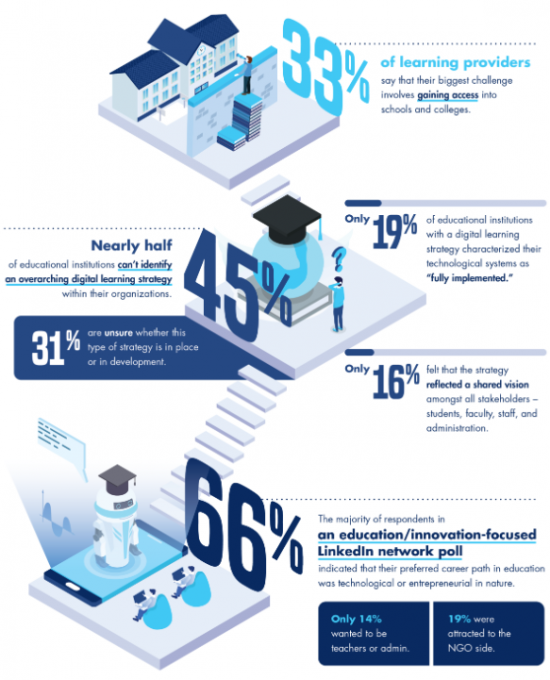 |
市場調查報告書
商品編碼
1346140
教育科技現況:後疫情時代的混合學習環境中的產品與市場契合度The State of EdTech: Product-Market Fit in a Post-COVID, Blended Learning Environment |
||||||
這份報告審視了全球教育科技市場,並對教育科技的轉型潛力、大流行期間的動態軌跡以及從這裡發展的可能風險和回報提供了多樣化和獨特的見解。我們也列出了進入市場的公司。
資訊圖表摘錄

目錄
第一章 教育科技現況簡介
- 本報告的主要優點
- 目標聽眾
- 本報告中提及的公司
- 調查方法
- 執行摘要
第 2 章案例研究:適合教育科技創新者的產品市場
- 將教育科技新創公司與機構和公共部門聯繫起來
- 財務准入和機構成本
- 技術敏捷性與新角色發展
- 回應多元化學習需求
- 教授解決複雜問題並促進全面發展
- 以數位方式解決工業技能差距
- 後電暈教育
- 數位風險和風險管理
第 3 章分析:教育科技產品市場契合策略與趨勢
- 增加VC並加速加速器
- 以客戶為中心的產品設計
- 對可訪問性的有意義的關注
- 迭代產品開發
- 人工智慧作為替代評估的推動者
- 採用混合式學習模式
- 技能提升與高階主管教育
- 數位化遷移與非破壞性教育科技的步伐
- 考慮更廣泛的組織和生態系統
- 持續適應疫情
- 提供充實的教育
- 服務全社會
第 4 章 資訊圖表:教育科技產品市場契合度的量化數據
上市公司
- Habitat Learn Group
- Kami
- Labster
- Logitech
- PopUp School
- Saint Mark's Episcopal School
- TITANS of CNC
- Tanjo AI
- Technovation
- University College London
"The State of EdTech: Product-Market Fit in a Post-COVID, Blended Learning Environment" is approximately 28,000 words (100 pages). This report has implications for innovators, investors, educators, and learners, detailing ways to drive long-term positive change while securing more immediate product-market fit.
Infographics Excerpt:

The second annual ‘Policy2050.com EdTech’ report provides diverse and unique insights into EdTech's transformative potential, its dynamic trajectory amid the pandemic, and the possible risks and rewards of its evolution from here. The report's conclusions highlight the urgent need for holistic understanding, strategic planning, and thoughtful execution.
This report will provide answers to the following questions:
- How can EdTech providers best achieve product-market fit?
- What are popular views on blended learning environments?
- How has the pandemic impacted the reputation and viability of EdTech?
- Which areas of EdTech are being overlooked?
- What are the benefits and risks of gamification and other digital trends?
- What strategies and trends signify potential growth trajectories for EdTech?
This thematic analysis is based on interviews with top EdTech innovators.
From innovative startup founders to those influencing the future directions of established tech firms and educational institutions, lengthy Zoom interviews were designed to capture the myriad ways in which EdTech is being developed and deployed.
Featured participants included:
- Gaurav Bradoo, Head of Product and Portfolio, Logitech for Education
- Richard Boyd, Co-founder and Chairman of Ultisim, CEO of Tanjo AI
- Titan Gilroy, CEO, TITANS of CNC
- Michael Bodekaer Jensen, Founder and CEO, Labster
- Hengjie Wang, Co-founder and CEO, Kami
- Jeremy Brassington, Co-founder and CEO, Habitat Learn Group
- Suren Aloyan, Co-founder and CEO, PopUp School
- Tara Chklovski, Founder and CEO, Technovation
- Marcus Pedersen, Learning Technologist, University College London
- Dr. Spencer Taintor, Head of School, Saint Mark's Episcopal School
The report aspired to answer the central question of EdTech product-market fit both qualitatively and quantitatively, by interviewing these EdTech leaders about the trends they were observing and collecting then visualizing data that speaks to the frequent sector misalignment.
Companies Mentionned
EdTech innovators and CEOs from the following technology providers and educational institutions directly participated in this primary research:
|
|
Target Audience
- Academic institutions evaluating EdTech procurement, best practices, and options
- EdTech innovators and their investors, for market research, competitive benchmarking, and post-COVID product-market fit
- Policymakers and NGOs seeking to improve or expand education, including through workforce reskilling or upskilling programs
Table of Contents
1. Introduction to the State of EdTech
- 1.1. Key Benefits of This Report
- 1.2. Target Audience
- 1.3. Companies Mentioned in This Report
- 1.4. Methodology
- 1.5. Executive Summary
2. Case Studies: EdTech Innovators' Product-Market Fit
- 2.1. Connecting EdTech Startups with Institutions and the Public Sector
- 2.2. Financial Accessibility and Institutional Costs
- 2.3. Technological Agility and the Development of New Roles
- 2.4. Addressing Diverse Learning Needs
- 2.5. Teaching Complex Problem-Solving and Encouraging Holistic Development
- 2.6. Digitally Addressing the Industrial Skills Gap
- 2.7. Post-COVID Education
- 2.8. Digital Risks and Risk Management
3. Analysis: Strategies and Trends for EdTech Product-Market Fit
- 3.1. Raising VC and Accelerating Accelerators
- 3.2. Customer-centric Product Design
- 3.3. A Meaningful Focus on Accessibility
- 3.4. Iterative Product Development
- 3.5. AI as a Driver of Alternative Assessments
- 3.6. Adoption of Blended Learning Models
- 3.7. Upskilling and Executive Education
- 3.8. Pace of Digital Transition and Non-Disruptive EdTech
- 3.9. Accounting for the Broader Organization and Ecosystem
- 3.10. Enduring Pandemic Adaptations
- 3.11. Delivering a Well-Rounded Education
- 3.12. Serving Society at Large













